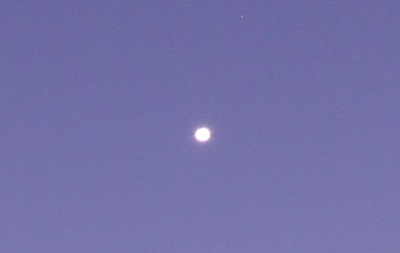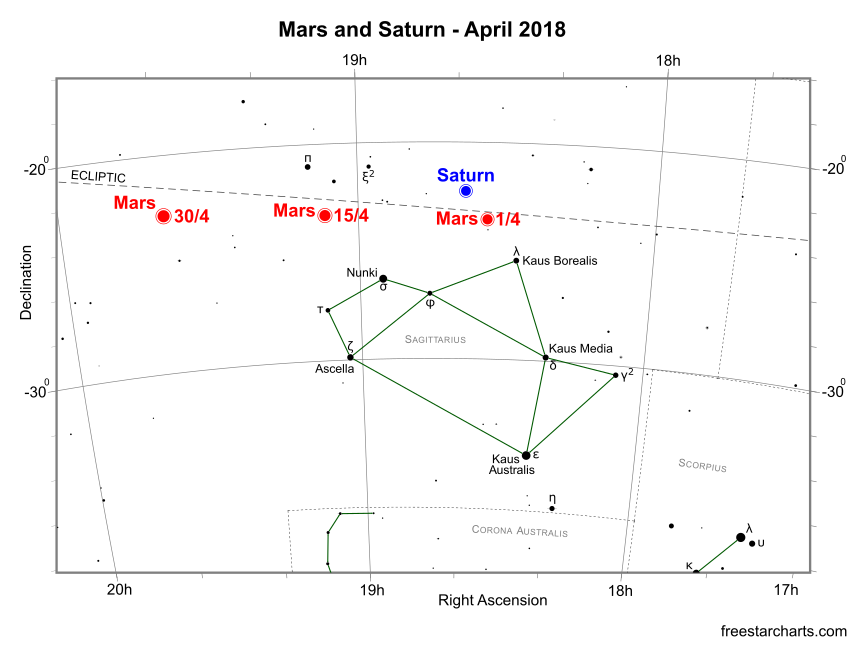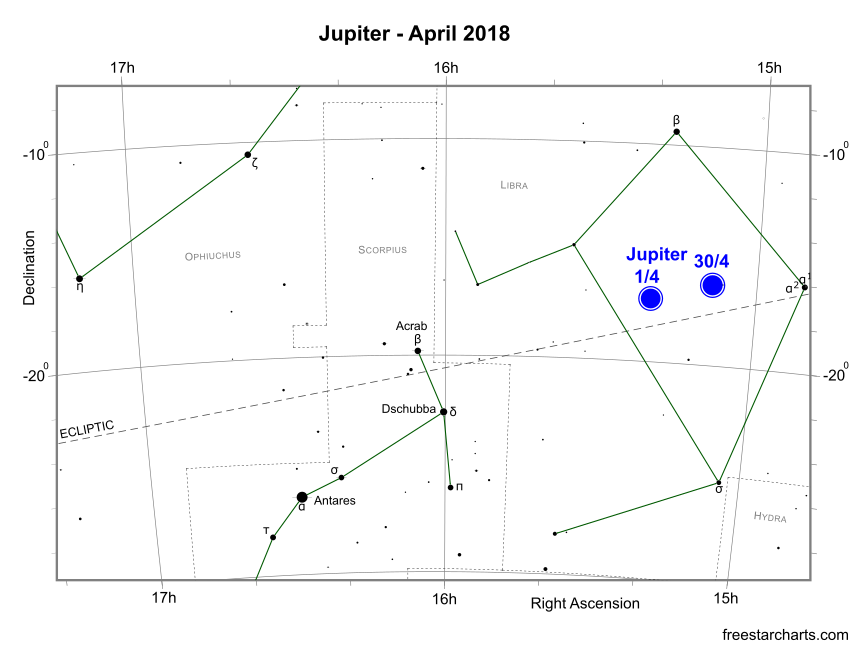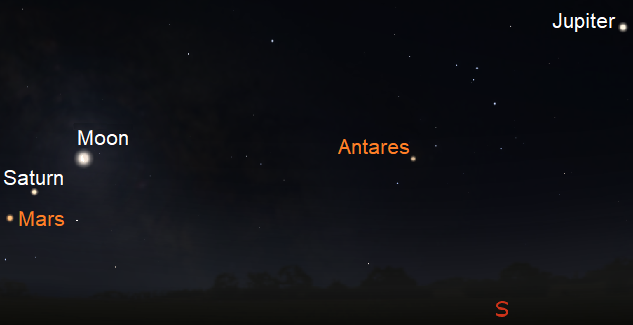Mercury
Mercury passes inferior conjunction on April 1st, but it doesn't take long before the planet rises out of the Sun's glare. It should be visible, low down above the eastern horizon before sunrise from tropical and southern latitudes by about the middle of the month. The planet subsequently brightens and climbs higher in the sky each morning until it reaches a peak altitude on April 29th, the date of greatest elongation west (27 degrees from the Sun). On this day, from latitude 35S (approx. equal to Sydney, Cape Town and Santiago), Mercury shines at mag. +0.3 and appears 17 degrees above the horizon, 45 minutes before sunrise. The very thin waning crescent Moon passes 4 degrees south of the planet on April 14th. On the 23rd, Mercury reaches aphelion when it's 0.467 AU (approx. 69.9 million kilometres or 43.4 million miles) distant from the Sun.
From northern temperate latitudes, this is not a great apparition due to the shallow angle of the ecliptic to the horizon and even at greatest elongation the planet appears low down. Observers will struggle to easily spot it.
Venus
Venus, mag. -3.9, is now a brilliant evening star that can be seen above the western horizon just after sunset. From northern temperature latitudes the planet sets about 2 hours after the Sun, although the visibility period is up to an hour less for those located further south.
During April, the apparent size of Venus increases from 10.6 to 11.5 arc seconds, with its illuminated disk decreasing from 94% to 89%. On April 17th, the thin waxing crescent Moon passes 5 degrees south of Venus, providing pleasant early evening viewing.

Mars
Mars is in Sagittarius and starts the month just southwest of Saturn. However, it doesn't take long before the red plant moves away from its more distant Solar System neighbour, and by months end the pair are separated by some 15 degrees. Mars is now starting to brighten nicely. On April 1st, the planet shines at magnitude +0.3, by month's end it's up to magnitude -0.3. During the same period, its apparent size increases from 8.5 to 11.0 arc seconds. At medium to high magnifications, it's now possible to make out the main surface details with a telescope, such as the Syrtis Major. For comparison, Saturn improves from magnitude +0.5 to +0.3 during this time, although it's apparent diameter is much larger at 17 arc seconds.
Mars, like Jupiter and Saturn, is currently better placed for observation from southern and tropical locations. From such locations, the planet rises just after midnight at the start of the month, improving to late evening by months end. From mid-latitude northern latitudes it appears much lower down and has a shorter visibility period. At months end, it rises during the early hours of the morning.
On April 7th, the waning crescent Moon passes 3 degrees north of Mars. Mars passes 1.4 degrees south of dwarf planet Pluto on April 26th. At magnitude +14.3, Pluto is a target for observers with large scopes. An instrument of at least 300mm (12-inch) aperture is recommended for this task.
.
Mars and Saturn during April 2018 - pdf format (credit:- freestarcharts)
Jupiter
Jupiter is now a brilliant object as it heads towards opposition in May. Throughout the month the gas giant continues to move retrograde amongst the faint stars of Libra. Jupiter is currently better seen from southern and equatorial latitudes, where it appears higher in the sky, compared to northern temperate locations. At the start of April, it rises mid-evening from tropical and southern locations and around midnight from mid-latitude northern temperate locations. By month's end, it's practically visible all night.
This month, Jupiter's magnitude brightens slightly from mag. -2.4 to -2.5 with its apparent diameter increasing from 42.6 to 44.6 arc seconds. The planet easily outshines all night-time stars. With binoculars or small telescopes up to four Galilean moons are visible (Io, Europa, Ganymede, Callisto). Telescopically, Jupiter is a gem and even small refractors will show much detail, including the main cloud belts. Medium and larger size scopes reveal considerably more detail, such as smaller belts, ovals, festoons and the well-known, but now shrinking, Great Red Spot.
On April 3rd and 30th, the waning gibbous Moon passes 4 degrees north of Jupiter.

Jupiter during April 2018 - pdf format (credit:- freestarcharts)
Saturn
Saturn is in Sagittarius and begins the month at magnitude +0.5, just over a degree northeast of slightly brighter Mars (mag. +0.3). The colour difference of the two planets is readily noticeable. Mars appears distinctly orange with Saturn creamy or off-white. As previously mentioned, it doesn't take long before Mars races off to the east and by month's end the two planets are separated by some 15 degrees.
On April 7th, the waning crescent Moon passes 2 degrees north of Saturn. On April 16th, Saturn reaches aphelion when it's 10.066 AU (approx. 1,505.9 million kilometres or 935.69 million miles) distant from the Sun. On the following day, the beautiful ringed planet reaches the first of its two stationary points. This date signals the change in apparent motion from direct to retrograde, and is widely regarded as the beginning of this year's opposition period. By the end of April, Saturn a couple of hours after midnight for observers at northern temperate latitudes, but up to 4 hours earlier for those located further south.
When seen through a telescope, Saturn is a wonderful sight. A small 80mm (3.1-inch) refractor easily reveals the ring system, which is currently wide open at a tilt of 26 degrees to the line of sight. A 150mm (6-inch) or 200mm (8-inch) reflector shows a wealth of details, such as planetary cloud formations, ring divisions and up to half a dozen satellites. During the month, the apparent diameter of Saturn's disk increases slightly from 16.7 to 17.5 arc seconds. On April 30th, it will shine at magnitude +0.3.

Uranus
Uranus reaches solar conjunction on April 18th and is therefore positioned too close to the Sun to be safely observed this month.
Neptune
Neptune, mag. +8.0, is located in the faint Aquarius and passed through solar conjunction at the beginning of last month. From northern temperate latitudes, the distant planet remains unsuitably placed for observation throughout April, but can be seen before sunrise towards the east from equatorial and southern regions. By months end, from such locations, it rises up to four hours before the Sun.
Although never bright enough to be seen with the naked eye, Neptune can be spotted with binoculars under dark skies. On April 12th, the thin waning crescent Moon passes 2 degrees south of Neptune.
Solar System Data Table - April 2018
| Date | Right Ascension | Declination | Mag. | App. Size | Illum. (%) | Dist. (AU) | Constellation | |
|---|---|---|---|---|---|---|---|---|
| Sun | Apr 01 | 00h 40m 19.6s | 04d 20m 22.1s | -26.7 | 32.0' | 100 | 0.999 | Pisces |
| Sun | Apr 15 | 01h 31m 38.4s | 09d 34m 42.2s | -26.7 | 31.9' | 100 | 1.003 | Pisces |
| Sun | Apr 30 | 02h 27m 51.9s | 14d 36m 39.1s | -26.7 | 31.8' | 100 | 1.007 | Aries |
| Mercury | Apr 01 | 00h 40m 37.2s | 07d 35m 46.0s | 6.5 | 11.2" | 1 | 0.601 | Pisces |
| Mercury | Apr 15 | 00h 17m 25.6s | 01d 21m 35.1s | 1.7 | 10.5" | 17 | 0.644 | Pisces |
| Mercury | Apr 30 | 00h 50m 17.2s | 02d 20m 23.1s | 0.3 | 8.0" | 44 | 0.843 | Cetus |
| Venus | Apr 01 | 01h 55m 08.2s | 11d 16m 46.5s | -3.9 | 10.6" | 94 | 1.578 | Aries |
| Venus | Apr 15 | 03h 01m 41.8s | 17d 17m 39.5s | -3.9 | 10.9" | 92 | 1.524 | Aries |
| Venus | Apr 30 | 04h 16m 41.5s | 22d 08m 17.9s | -3.9 | 11.5" | 89 | 1.455 | Taurus |
| Mars | Apr 01 | 18h 34m 01.5s | -23d 33m 05.5s | 0.3 | 8.5" | 88 | 1.108 | Sagittarius |
| Mars | Apr 15 | 19h 06m 43.7s | -23d 17m 48.2s | 0.0 | 9.5" | 88 | 0.982 | Sagittarius |
| Mars | Apr 30 | 19h 39m 01.2s | -22d 46m 32.4s | -0.3 | 11.0" | 88 | 0.853 | Sagittarius |
| Jupiter | Apr 01 | 15h 20m 21.3s | -17d 05m 45.0s | -2.4 | 42.6" | 100 | 4.625 | Libra |
| Jupiter | Apr 15 | 15h 15m 29.4s | -16d 45m 56.2s | -2.4 | 43.8" | 100 | 4.496 | Libra |
| Jupiter | Apr 30 | 15h 08m 35.3s | -16d 18m 20.0s | -2.5 | 44.6" | 100 | 4.416 | Libra |
| Saturn | Apr 01 | 18h 37m 26.6s | -22d 16m 26.6s | 0.5 | 16.7" | 100 | 9.976 | Sagittarius |
| Saturn | Apr 15 | 18h 38m 26.2s | -22d 15m 20.9s | 0.4 | 17.1" | 100 | 9.745 | Sagittarius |
| Saturn | Apr 30 | 18h 37m 57.8s | -22d 15m 40.0s | 0.3 | 17.5" | 100 | 9.516 | Sagittarius |
| Uranus | Apr 01 | 01h 41m 54.5s | 09d 59m 48.8s | 5.9 | 3.4" | 100 | 20.850 | Pisces |
| Uranus | Apr 15 | 01h 44m 54.7s | 10d 16m 58.1s | 5.9 | 3.4" | 100 | 20.893 | Pisces |
| Uranus | Apr 30 | 01h 48m 10.1s | 10d 35m 19.0s | 5.9 | 3.4" | 100 | 20.879 | Aries |
| Neptune | Apr 01 | 23h 05m 03.5s | -06d 52m 02.9s | 8.0 | 2.2" | 100 | 30.836 | Aquarius |
| Neptune | Apr 15 | 23h 06m 46.8s | -06d 41m 40.4s | 8.0 | 2.2" | 100 | 30.709 | Aquarius |
| Neptune | Apr 30 | 23h 08m 21.6s | -06d 32m 17.1s | 7.9 | 2.2" | 100 | 30.527 | Aquarius |